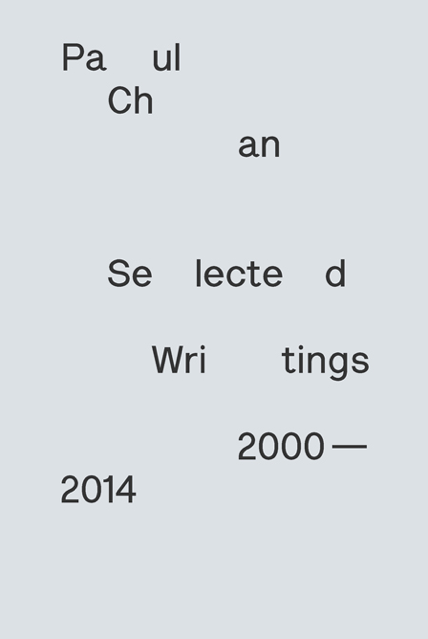Back in 2009, Paul Chan took a timeout from making art. This summer sees his first major solo exhibition since 2008, at the Schaulager in Basel, an event marked by the publication of this substantial collection of his writings. Given that sabbatical (during which the Hong Kong-born, New York-based artist set up his Badlands Unlimited publishing house), perhaps it’s fitting too that the first section of the book brings together a series of texts – ‘What Art Is and Where It Belongs’ and ‘On Art and the 99 Percent’ among them – that, at their heart, consider questions concerning the definition of art and its role in society, with a particular focus on its relation to ideas of home and community, much of it in the context of America’s wars in Iraq and Afghanistan, and the subsequent global economic recession.
‘For outsider art, the duty is to the law, not to the new (or more precisely the longing to the new), which is the calling of contemporary art’
In the main, these texts were originally presented in art magazines or as lectures (a form that Chan, often deploying an extremely entertaining mixture of philosophic reference – Hegel figures prominently – and personal experience, is particularly skilled in delivering), but as you read through them collectively, they offer up a series of aphoristic statements concerning the nature of their author’s profession: ‘I am an artist. And artists are one way or another, obsessed with form.’ ‘For outsider art, the duty is to the law, not to the new (or more precisely the longing to the new), which is the calling of contemporary art.’ ‘Art uses things to make its presence felt. But art is not in itself a thing.’ ‘To find the courage to say the very last words and to make them sing like the recessional to the very last service, this is what I call art.’ And you’re left with a sense that despite the clarity and assurance of Chan’s writing, he’s responding to a series of widespread insecurities about art and its purpose in the world today (in the context of a general view of art as a commodity available only to an economic and social elite, and at risk of becoming disconnected from the ‘real’ issues that affect contemporary living – military and economic conflict, political oppression, the effects of natural disasters such as Hurricane Katrina, etc – many of which Chan has taken the trouble to engage with, travelling to Baghdad and New Orleans).
It’s a theme that continues in the next section, which collects texts relating specifically to Chan’s own work and practice. The short text ‘On the Difference between a Work and a Project’, for example, begins with the statement, ‘I make work and have done projects’, and leads to a discussion of how, in 2011, the idea of ‘work’ has changed given that 9.6 percent of the American population lack it. A ‘project’, Chan states, ‘encompasses the making of something that is not dependent on work’.
Which in turn leads to the presentation of a series of Chan’s artworks – the Alternumerics – involving computer fonts that replace letters with text and graphic fragments (in Oh Bishop X, 2008, ‘m’ becomes ‘useless…’ and ‘n’ ‘a dud…’; others have included a ‘self-portrait’ font that enables you to write like Chan) and that both reduce (‘I got greedy. I wanted language to work only for me and no one else,’ Chan says) and expand (download the font – it’s free – connect to a printer and you can make an artwork) the possibilities of language, technology and artmaking. ‘Think Diderot’s Encyclopedia. Think Socialism.’ Chan writes.
‘I am not at all sure what I achieve in my writing. I am pretty sure nothing much is achieved in the art’
The final section of the book collects Chan’s writing on others, among them artists – Chris Marker, Rachel Harrison, Marcel Duchamp – thinkers – Theodor W. Adorno – and even curators – Hans Ulrich Obrist. It’s a personal artworld, if you like. There’s also the introduction to a 2012 Badlands publication (coinciding with the US presidential elections) of three idealistic speeches on democracy written by Saddam Hussein during the 1970s that expose the slipperiness of language (Chan points out that Hussein’s thoughts are not far removed from the idea of democracy peddled by US politicians) and, perhaps more pertinently, the gap between discourse and action.
‘I am not at all sure what I achieve in my writing. I am pretty sure nothing much is achieved in the art,’ Chan recently stated in an interview with Noelle Bodick on artspace.com. On the evidence of this collection, Chan is one of the more important commentators on the state of art today, not least for giving the impression that we are able to shape, rather than accept, what art is and can do.
This article was first published in the Summer 2014 issue.
